Health Promotion for Patients with Intellectual Disability Essay
VerifiedAdded on 2022/11/25
|11
|3058
|349
Essay
AI Summary
This essay delves into health promotion strategies for patients with intellectual disabilities, focusing on effective communication and its impact on patient outcomes. The essay begins by comparing and contrasting the communication skills, behaviors, and attitudes of two nurses using the ANSAT behavioral cues tool, highlighting key differences in their interactions with a patient with an intellectual disability. It then outlines specific communication strategies, such as slowing down speech and using visual aids, to improve health literacy among this patient population. Furthermore, the essay examines relevant health policies and government directives in Australia, emphasizing the importance of equity and equality in healthcare access for individuals with intellectual disabilities. The analysis incorporates the Nursing and Midwifery Board of Australia (NMBA) guidelines, emphasizing the ethical responsibilities of healthcare professionals. The essay concludes by underscoring the significance of effective communication and equitable healthcare access in promoting patient satisfaction and well-being.
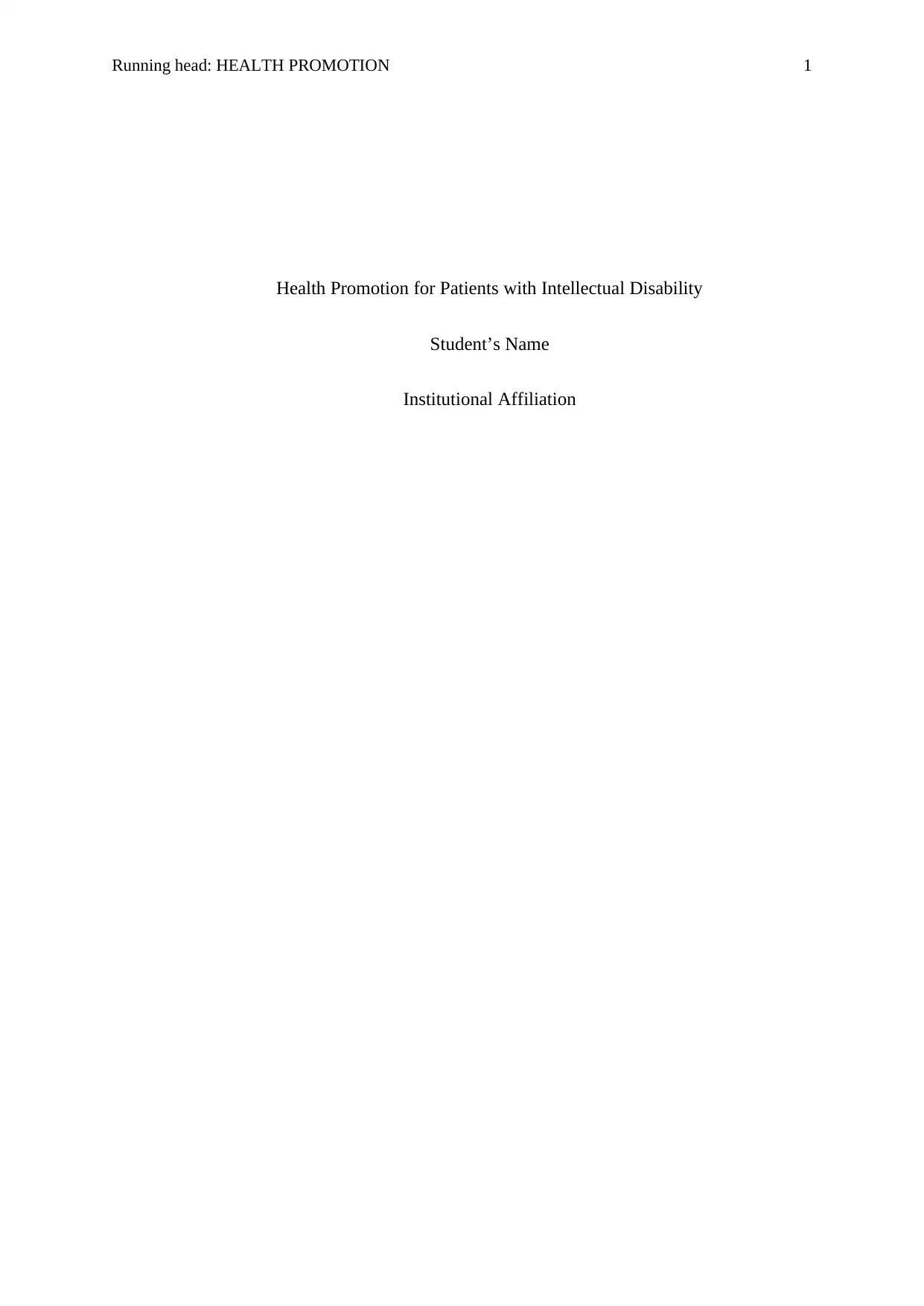
Running head: HEALTH PROMOTION 1
Health Promotion for Patients with Intellectual Disability
Student’s Name
Institutional Affiliation
Health Promotion for Patients with Intellectual Disability
Student’s Name
Institutional Affiliation
Paraphrase This Document
Need a fresh take? Get an instant paraphrase of this document with our AI Paraphraser
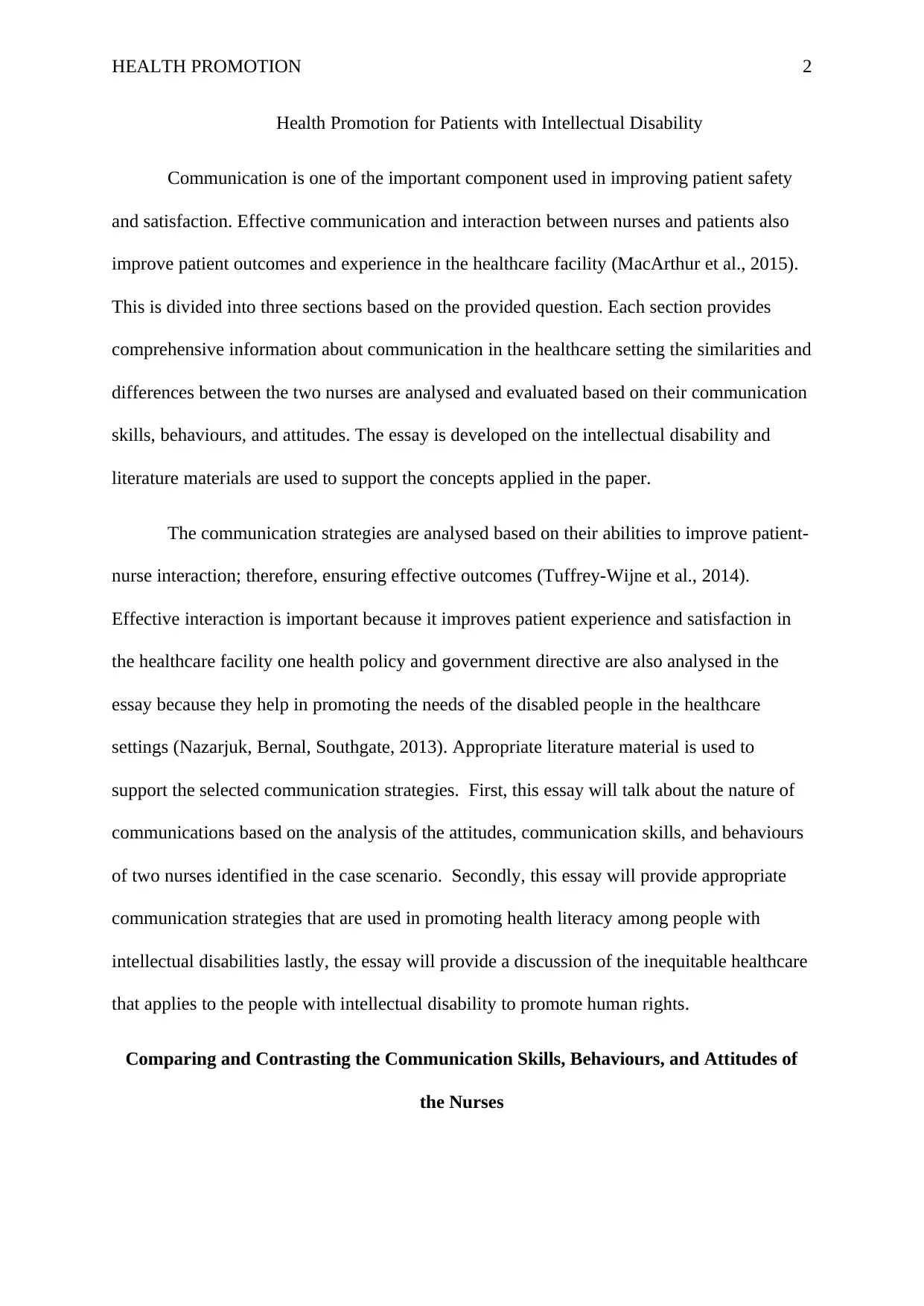
HEALTH PROMOTION 2
Health Promotion for Patients with Intellectual Disability
Communication is one of the important component used in improving patient safety
and satisfaction. Effective communication and interaction between nurses and patients also
improve patient outcomes and experience in the healthcare facility (MacArthur et al., 2015).
This is divided into three sections based on the provided question. Each section provides
comprehensive information about communication in the healthcare setting the similarities and
differences between the two nurses are analysed and evaluated based on their communication
skills, behaviours, and attitudes. The essay is developed on the intellectual disability and
literature materials are used to support the concepts applied in the paper.
The communication strategies are analysed based on their abilities to improve patient-
nurse interaction; therefore, ensuring effective outcomes (Tuffrey-Wijne et al., 2014).
Effective interaction is important because it improves patient experience and satisfaction in
the healthcare facility one health policy and government directive are also analysed in the
essay because they help in promoting the needs of the disabled people in the healthcare
settings (Nazarjuk, Bernal, Southgate, 2013). Appropriate literature material is used to
support the selected communication strategies. First, this essay will talk about the nature of
communications based on the analysis of the attitudes, communication skills, and behaviours
of two nurses identified in the case scenario. Secondly, this essay will provide appropriate
communication strategies that are used in promoting health literacy among people with
intellectual disabilities lastly, the essay will provide a discussion of the inequitable healthcare
that applies to the people with intellectual disability to promote human rights.
Comparing and Contrasting the Communication Skills, Behaviours, and Attitudes of
the Nurses
Health Promotion for Patients with Intellectual Disability
Communication is one of the important component used in improving patient safety
and satisfaction. Effective communication and interaction between nurses and patients also
improve patient outcomes and experience in the healthcare facility (MacArthur et al., 2015).
This is divided into three sections based on the provided question. Each section provides
comprehensive information about communication in the healthcare setting the similarities and
differences between the two nurses are analysed and evaluated based on their communication
skills, behaviours, and attitudes. The essay is developed on the intellectual disability and
literature materials are used to support the concepts applied in the paper.
The communication strategies are analysed based on their abilities to improve patient-
nurse interaction; therefore, ensuring effective outcomes (Tuffrey-Wijne et al., 2014).
Effective interaction is important because it improves patient experience and satisfaction in
the healthcare facility one health policy and government directive are also analysed in the
essay because they help in promoting the needs of the disabled people in the healthcare
settings (Nazarjuk, Bernal, Southgate, 2013). Appropriate literature material is used to
support the selected communication strategies. First, this essay will talk about the nature of
communications based on the analysis of the attitudes, communication skills, and behaviours
of two nurses identified in the case scenario. Secondly, this essay will provide appropriate
communication strategies that are used in promoting health literacy among people with
intellectual disabilities lastly, the essay will provide a discussion of the inequitable healthcare
that applies to the people with intellectual disability to promote human rights.
Comparing and Contrasting the Communication Skills, Behaviours, and Attitudes of
the Nurses
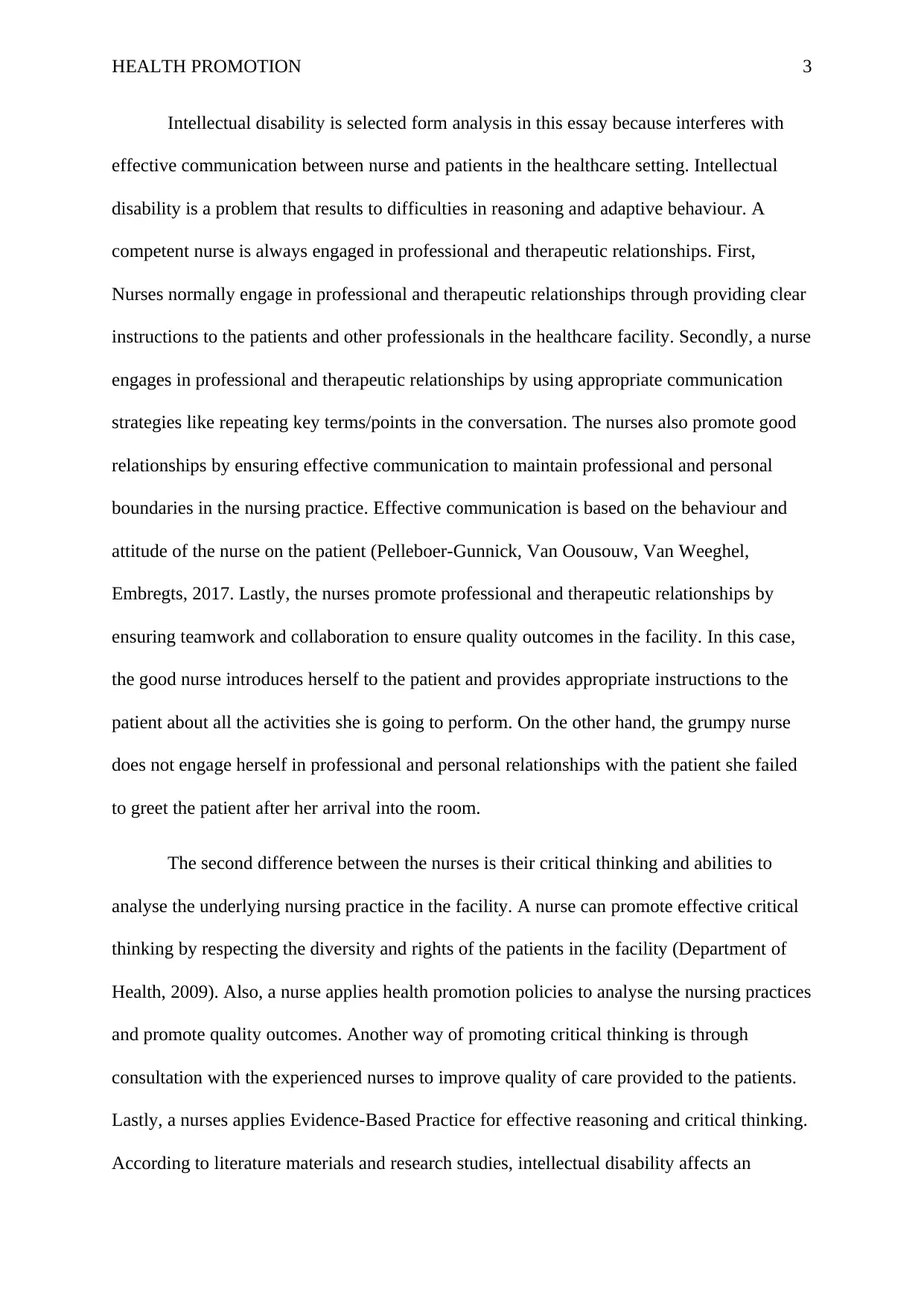
HEALTH PROMOTION 3
Intellectual disability is selected form analysis in this essay because interferes with
effective communication between nurse and patients in the healthcare setting. Intellectual
disability is a problem that results to difficulties in reasoning and adaptive behaviour. A
competent nurse is always engaged in professional and therapeutic relationships. First,
Nurses normally engage in professional and therapeutic relationships through providing clear
instructions to the patients and other professionals in the healthcare facility. Secondly, a nurse
engages in professional and therapeutic relationships by using appropriate communication
strategies like repeating key terms/points in the conversation. The nurses also promote good
relationships by ensuring effective communication to maintain professional and personal
boundaries in the nursing practice. Effective communication is based on the behaviour and
attitude of the nurse on the patient (Pelleboer-Gunnick, Van Oousouw, Van Weeghel,
Embregts, 2017. Lastly, the nurses promote professional and therapeutic relationships by
ensuring teamwork and collaboration to ensure quality outcomes in the facility. In this case,
the good nurse introduces herself to the patient and provides appropriate instructions to the
patient about all the activities she is going to perform. On the other hand, the grumpy nurse
does not engage herself in professional and personal relationships with the patient she failed
to greet the patient after her arrival into the room.
The second difference between the nurses is their critical thinking and abilities to
analyse the underlying nursing practice in the facility. A nurse can promote effective critical
thinking by respecting the diversity and rights of the patients in the facility (Department of
Health, 2009). Also, a nurse applies health promotion policies to analyse the nursing practices
and promote quality outcomes. Another way of promoting critical thinking is through
consultation with the experienced nurses to improve quality of care provided to the patients.
Lastly, a nurses applies Evidence-Based Practice for effective reasoning and critical thinking.
According to literature materials and research studies, intellectual disability affects an
Intellectual disability is selected form analysis in this essay because interferes with
effective communication between nurse and patients in the healthcare setting. Intellectual
disability is a problem that results to difficulties in reasoning and adaptive behaviour. A
competent nurse is always engaged in professional and therapeutic relationships. First,
Nurses normally engage in professional and therapeutic relationships through providing clear
instructions to the patients and other professionals in the healthcare facility. Secondly, a nurse
engages in professional and therapeutic relationships by using appropriate communication
strategies like repeating key terms/points in the conversation. The nurses also promote good
relationships by ensuring effective communication to maintain professional and personal
boundaries in the nursing practice. Effective communication is based on the behaviour and
attitude of the nurse on the patient (Pelleboer-Gunnick, Van Oousouw, Van Weeghel,
Embregts, 2017. Lastly, the nurses promote professional and therapeutic relationships by
ensuring teamwork and collaboration to ensure quality outcomes in the facility. In this case,
the good nurse introduces herself to the patient and provides appropriate instructions to the
patient about all the activities she is going to perform. On the other hand, the grumpy nurse
does not engage herself in professional and personal relationships with the patient she failed
to greet the patient after her arrival into the room.
The second difference between the nurses is their critical thinking and abilities to
analyse the underlying nursing practice in the facility. A nurse can promote effective critical
thinking by respecting the diversity and rights of the patients in the facility (Department of
Health, 2009). Also, a nurse applies health promotion policies to analyse the nursing practices
and promote quality outcomes. Another way of promoting critical thinking is through
consultation with the experienced nurses to improve quality of care provided to the patients.
Lastly, a nurses applies Evidence-Based Practice for effective reasoning and critical thinking.
According to literature materials and research studies, intellectual disability affects an
⊘ This is a preview!⊘
Do you want full access?
Subscribe today to unlock all pages.

Trusted by 1+ million students worldwide
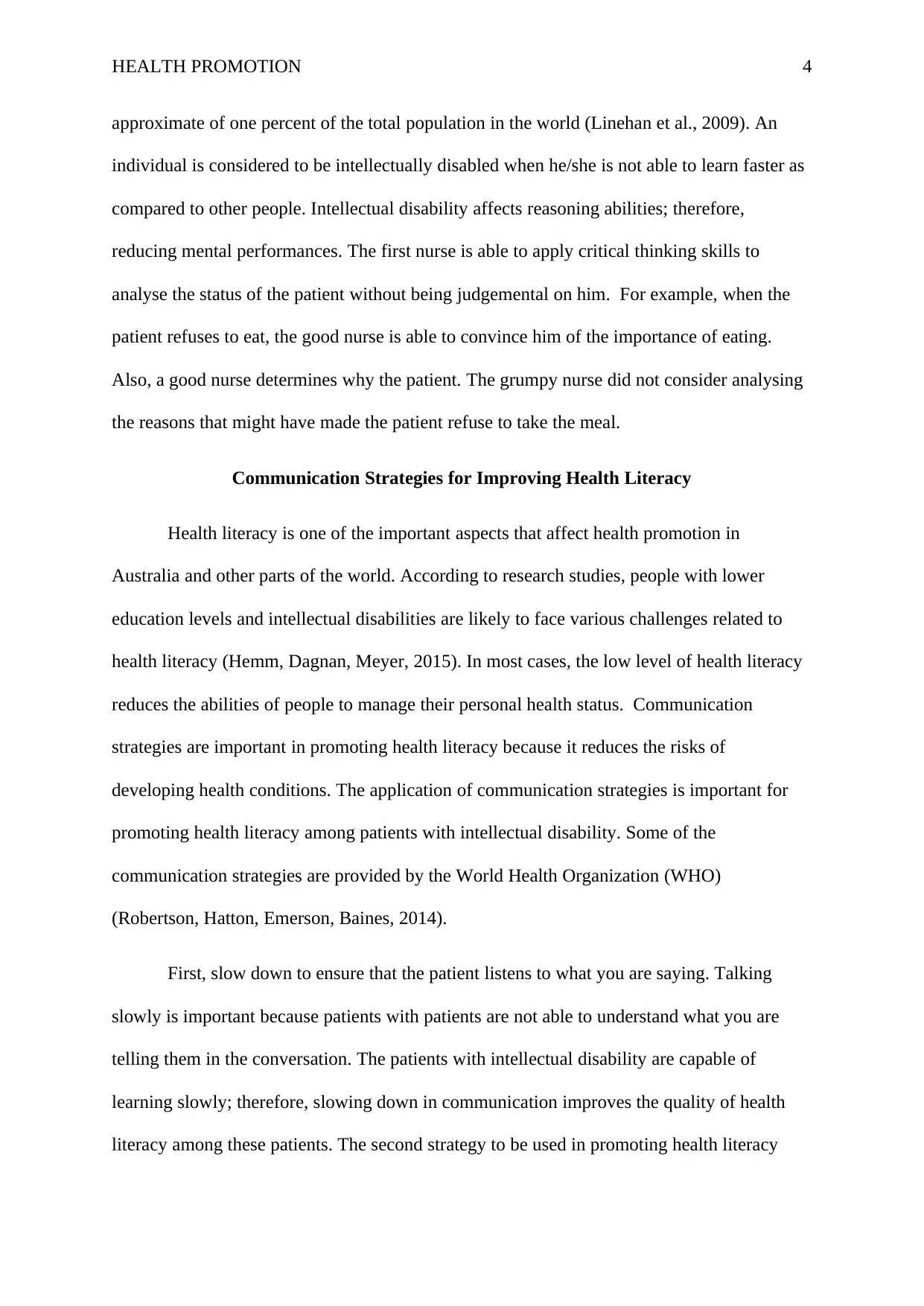
HEALTH PROMOTION 4
approximate of one percent of the total population in the world (Linehan et al., 2009). An
individual is considered to be intellectually disabled when he/she is not able to learn faster as
compared to other people. Intellectual disability affects reasoning abilities; therefore,
reducing mental performances. The first nurse is able to apply critical thinking skills to
analyse the status of the patient without being judgemental on him. For example, when the
patient refuses to eat, the good nurse is able to convince him of the importance of eating.
Also, a good nurse determines why the patient. The grumpy nurse did not consider analysing
the reasons that might have made the patient refuse to take the meal.
Communication Strategies for Improving Health Literacy
Health literacy is one of the important aspects that affect health promotion in
Australia and other parts of the world. According to research studies, people with lower
education levels and intellectual disabilities are likely to face various challenges related to
health literacy (Hemm, Dagnan, Meyer, 2015). In most cases, the low level of health literacy
reduces the abilities of people to manage their personal health status. Communication
strategies are important in promoting health literacy because it reduces the risks of
developing health conditions. The application of communication strategies is important for
promoting health literacy among patients with intellectual disability. Some of the
communication strategies are provided by the World Health Organization (WHO)
(Robertson, Hatton, Emerson, Baines, 2014).
First, slow down to ensure that the patient listens to what you are saying. Talking
slowly is important because patients with patients are not able to understand what you are
telling them in the conversation. The patients with intellectual disability are capable of
learning slowly; therefore, slowing down in communication improves the quality of health
literacy among these patients. The second strategy to be used in promoting health literacy
approximate of one percent of the total population in the world (Linehan et al., 2009). An
individual is considered to be intellectually disabled when he/she is not able to learn faster as
compared to other people. Intellectual disability affects reasoning abilities; therefore,
reducing mental performances. The first nurse is able to apply critical thinking skills to
analyse the status of the patient without being judgemental on him. For example, when the
patient refuses to eat, the good nurse is able to convince him of the importance of eating.
Also, a good nurse determines why the patient. The grumpy nurse did not consider analysing
the reasons that might have made the patient refuse to take the meal.
Communication Strategies for Improving Health Literacy
Health literacy is one of the important aspects that affect health promotion in
Australia and other parts of the world. According to research studies, people with lower
education levels and intellectual disabilities are likely to face various challenges related to
health literacy (Hemm, Dagnan, Meyer, 2015). In most cases, the low level of health literacy
reduces the abilities of people to manage their personal health status. Communication
strategies are important in promoting health literacy because it reduces the risks of
developing health conditions. The application of communication strategies is important for
promoting health literacy among patients with intellectual disability. Some of the
communication strategies are provided by the World Health Organization (WHO)
(Robertson, Hatton, Emerson, Baines, 2014).
First, slow down to ensure that the patient listens to what you are saying. Talking
slowly is important because patients with patients are not able to understand what you are
telling them in the conversation. The patients with intellectual disability are capable of
learning slowly; therefore, slowing down in communication improves the quality of health
literacy among these patients. The second strategy to be used in promoting health literacy
Paraphrase This Document
Need a fresh take? Get an instant paraphrase of this document with our AI Paraphraser
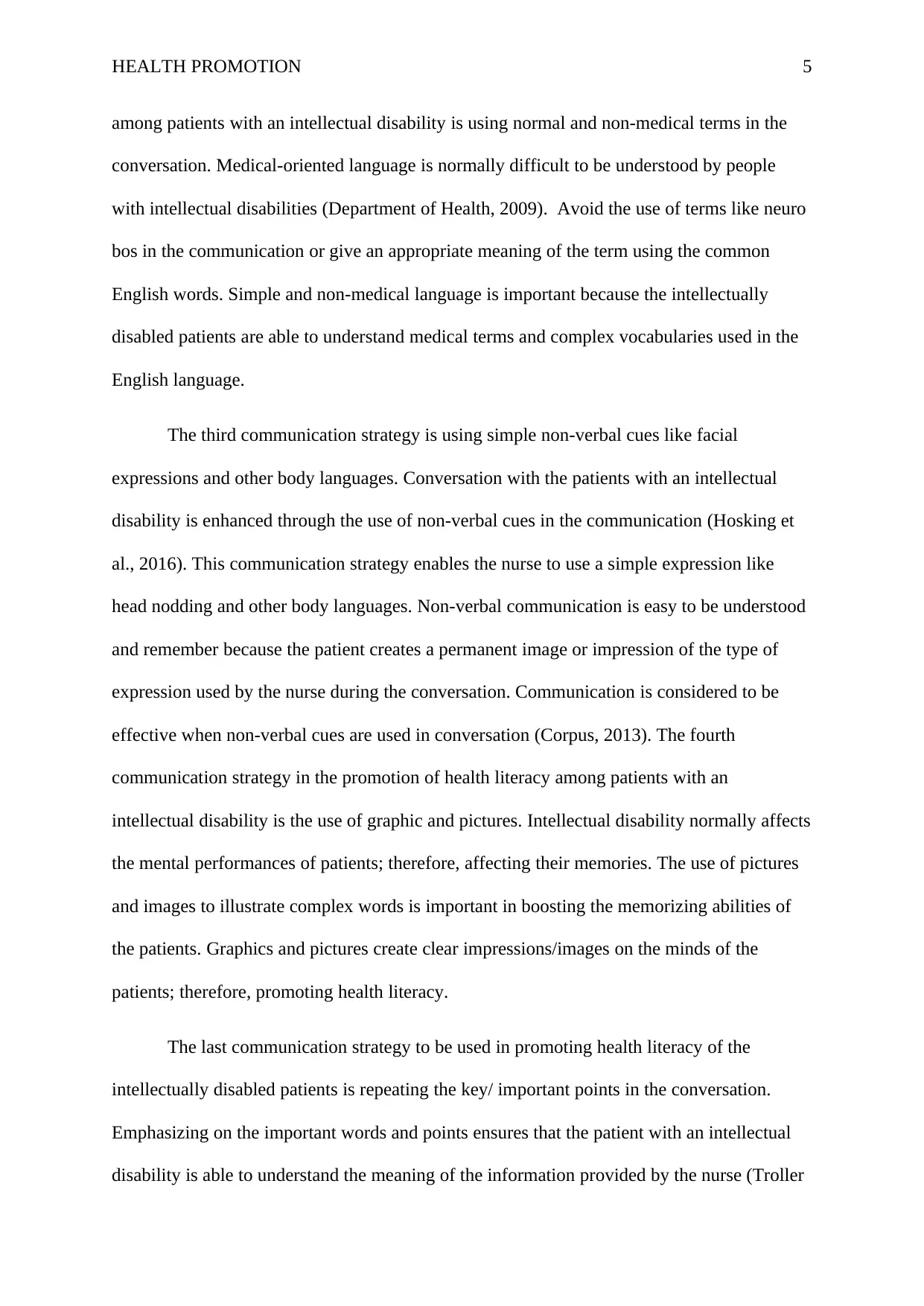
HEALTH PROMOTION 5
among patients with an intellectual disability is using normal and non-medical terms in the
conversation. Medical-oriented language is normally difficult to be understood by people
with intellectual disabilities (Department of Health, 2009). Avoid the use of terms like neuro
bos in the communication or give an appropriate meaning of the term using the common
English words. Simple and non-medical language is important because the intellectually
disabled patients are able to understand medical terms and complex vocabularies used in the
English language.
The third communication strategy is using simple non-verbal cues like facial
expressions and other body languages. Conversation with the patients with an intellectual
disability is enhanced through the use of non-verbal cues in the communication (Hosking et
al., 2016). This communication strategy enables the nurse to use a simple expression like
head nodding and other body languages. Non-verbal communication is easy to be understood
and remember because the patient creates a permanent image or impression of the type of
expression used by the nurse during the conversation. Communication is considered to be
effective when non-verbal cues are used in conversation (Corpus, 2013). The fourth
communication strategy in the promotion of health literacy among patients with an
intellectual disability is the use of graphic and pictures. Intellectual disability normally affects
the mental performances of patients; therefore, affecting their memories. The use of pictures
and images to illustrate complex words is important in boosting the memorizing abilities of
the patients. Graphics and pictures create clear impressions/images on the minds of the
patients; therefore, promoting health literacy.
The last communication strategy to be used in promoting health literacy of the
intellectually disabled patients is repeating the key/ important points in the conversation.
Emphasizing on the important words and points ensures that the patient with an intellectual
disability is able to understand the meaning of the information provided by the nurse (Troller
among patients with an intellectual disability is using normal and non-medical terms in the
conversation. Medical-oriented language is normally difficult to be understood by people
with intellectual disabilities (Department of Health, 2009). Avoid the use of terms like neuro
bos in the communication or give an appropriate meaning of the term using the common
English words. Simple and non-medical language is important because the intellectually
disabled patients are able to understand medical terms and complex vocabularies used in the
English language.
The third communication strategy is using simple non-verbal cues like facial
expressions and other body languages. Conversation with the patients with an intellectual
disability is enhanced through the use of non-verbal cues in the communication (Hosking et
al., 2016). This communication strategy enables the nurse to use a simple expression like
head nodding and other body languages. Non-verbal communication is easy to be understood
and remember because the patient creates a permanent image or impression of the type of
expression used by the nurse during the conversation. Communication is considered to be
effective when non-verbal cues are used in conversation (Corpus, 2013). The fourth
communication strategy in the promotion of health literacy among patients with an
intellectual disability is the use of graphic and pictures. Intellectual disability normally affects
the mental performances of patients; therefore, affecting their memories. The use of pictures
and images to illustrate complex words is important in boosting the memorizing abilities of
the patients. Graphics and pictures create clear impressions/images on the minds of the
patients; therefore, promoting health literacy.
The last communication strategy to be used in promoting health literacy of the
intellectually disabled patients is repeating the key/ important points in the conversation.
Emphasizing on the important words and points ensures that the patient with an intellectual
disability is able to understand the meaning of the information provided by the nurse (Troller
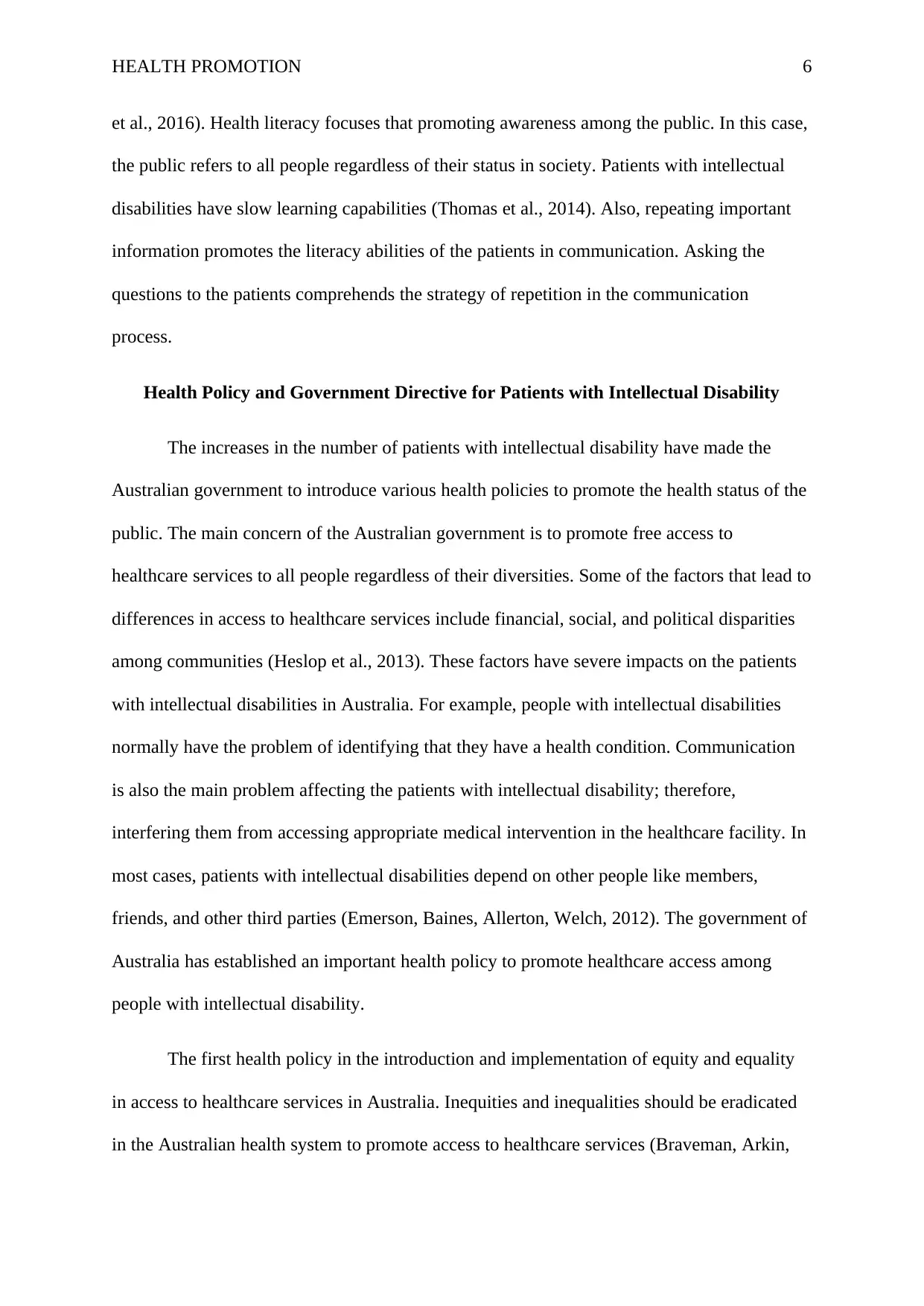
HEALTH PROMOTION 6
et al., 2016). Health literacy focuses that promoting awareness among the public. In this case,
the public refers to all people regardless of their status in society. Patients with intellectual
disabilities have slow learning capabilities (Thomas et al., 2014). Also, repeating important
information promotes the literacy abilities of the patients in communication. Asking the
questions to the patients comprehends the strategy of repetition in the communication
process.
Health Policy and Government Directive for Patients with Intellectual Disability
The increases in the number of patients with intellectual disability have made the
Australian government to introduce various health policies to promote the health status of the
public. The main concern of the Australian government is to promote free access to
healthcare services to all people regardless of their diversities. Some of the factors that lead to
differences in access to healthcare services include financial, social, and political disparities
among communities (Heslop et al., 2013). These factors have severe impacts on the patients
with intellectual disabilities in Australia. For example, people with intellectual disabilities
normally have the problem of identifying that they have a health condition. Communication
is also the main problem affecting the patients with intellectual disability; therefore,
interfering them from accessing appropriate medical intervention in the healthcare facility. In
most cases, patients with intellectual disabilities depend on other people like members,
friends, and other third parties (Emerson, Baines, Allerton, Welch, 2012). The government of
Australia has established an important health policy to promote healthcare access among
people with intellectual disability.
The first health policy in the introduction and implementation of equity and equality
in access to healthcare services in Australia. Inequities and inequalities should be eradicated
in the Australian health system to promote access to healthcare services (Braveman, Arkin,
et al., 2016). Health literacy focuses that promoting awareness among the public. In this case,
the public refers to all people regardless of their status in society. Patients with intellectual
disabilities have slow learning capabilities (Thomas et al., 2014). Also, repeating important
information promotes the literacy abilities of the patients in communication. Asking the
questions to the patients comprehends the strategy of repetition in the communication
process.
Health Policy and Government Directive for Patients with Intellectual Disability
The increases in the number of patients with intellectual disability have made the
Australian government to introduce various health policies to promote the health status of the
public. The main concern of the Australian government is to promote free access to
healthcare services to all people regardless of their diversities. Some of the factors that lead to
differences in access to healthcare services include financial, social, and political disparities
among communities (Heslop et al., 2013). These factors have severe impacts on the patients
with intellectual disabilities in Australia. For example, people with intellectual disabilities
normally have the problem of identifying that they have a health condition. Communication
is also the main problem affecting the patients with intellectual disability; therefore,
interfering them from accessing appropriate medical intervention in the healthcare facility. In
most cases, patients with intellectual disabilities depend on other people like members,
friends, and other third parties (Emerson, Baines, Allerton, Welch, 2012). The government of
Australia has established an important health policy to promote healthcare access among
people with intellectual disability.
The first health policy in the introduction and implementation of equity and equality
in access to healthcare services in Australia. Inequities and inequalities should be eradicated
in the Australian health system to promote access to healthcare services (Braveman, Arkin,
⊘ This is a preview!⊘
Do you want full access?
Subscribe today to unlock all pages.

Trusted by 1+ million students worldwide
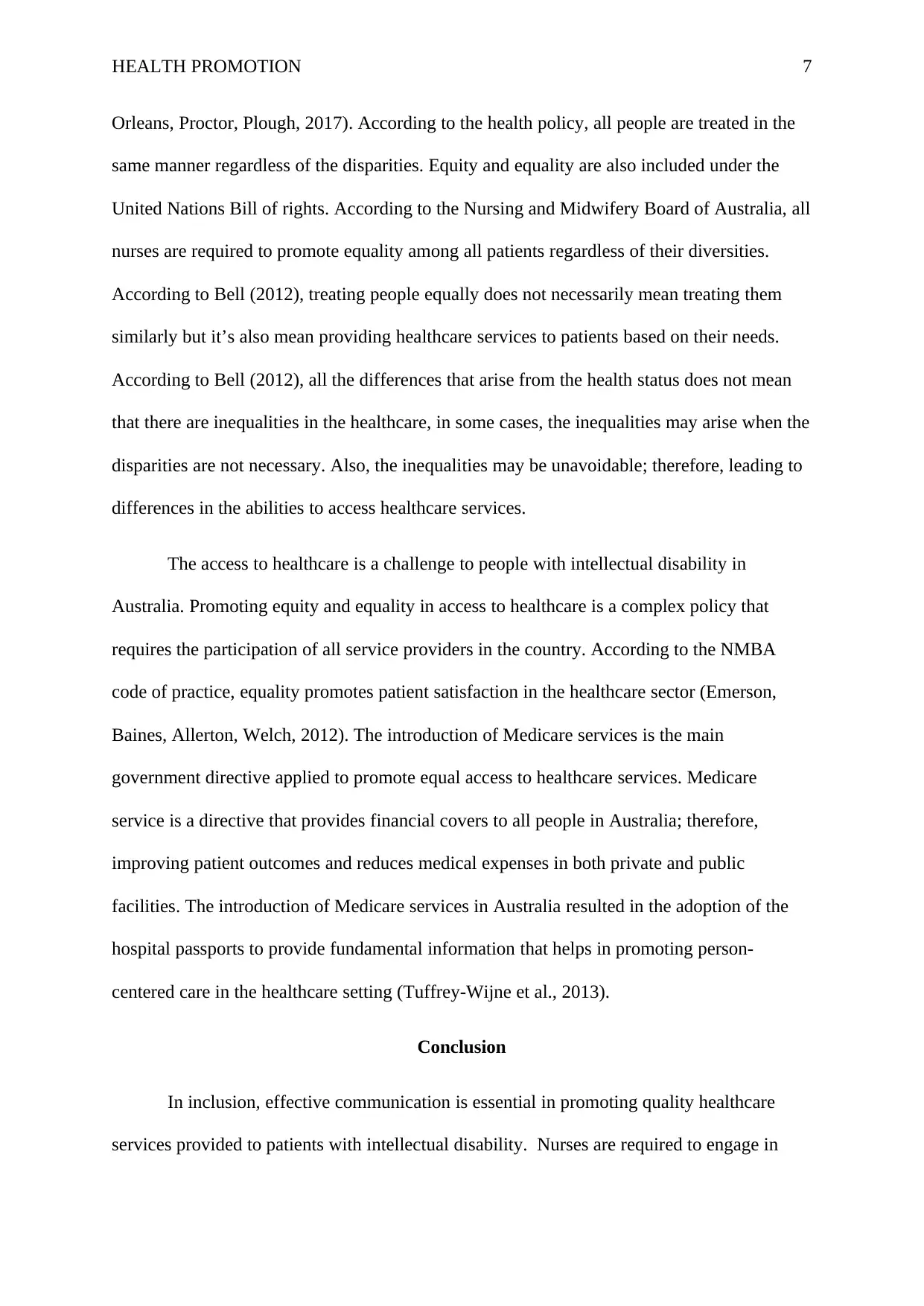
HEALTH PROMOTION 7
Orleans, Proctor, Plough, 2017). According to the health policy, all people are treated in the
same manner regardless of the disparities. Equity and equality are also included under the
United Nations Bill of rights. According to the Nursing and Midwifery Board of Australia, all
nurses are required to promote equality among all patients regardless of their diversities.
According to Bell (2012), treating people equally does not necessarily mean treating them
similarly but it’s also mean providing healthcare services to patients based on their needs.
According to Bell (2012), all the differences that arise from the health status does not mean
that there are inequalities in the healthcare, in some cases, the inequalities may arise when the
disparities are not necessary. Also, the inequalities may be unavoidable; therefore, leading to
differences in the abilities to access healthcare services.
The access to healthcare is a challenge to people with intellectual disability in
Australia. Promoting equity and equality in access to healthcare is a complex policy that
requires the participation of all service providers in the country. According to the NMBA
code of practice, equality promotes patient satisfaction in the healthcare sector (Emerson,
Baines, Allerton, Welch, 2012). The introduction of Medicare services is the main
government directive applied to promote equal access to healthcare services. Medicare
service is a directive that provides financial covers to all people in Australia; therefore,
improving patient outcomes and reduces medical expenses in both private and public
facilities. The introduction of Medicare services in Australia resulted in the adoption of the
hospital passports to provide fundamental information that helps in promoting person-
centered care in the healthcare setting (Tuffrey-Wijne et al., 2013).
Conclusion
In inclusion, effective communication is essential in promoting quality healthcare
services provided to patients with intellectual disability. Nurses are required to engage in
Orleans, Proctor, Plough, 2017). According to the health policy, all people are treated in the
same manner regardless of the disparities. Equity and equality are also included under the
United Nations Bill of rights. According to the Nursing and Midwifery Board of Australia, all
nurses are required to promote equality among all patients regardless of their diversities.
According to Bell (2012), treating people equally does not necessarily mean treating them
similarly but it’s also mean providing healthcare services to patients based on their needs.
According to Bell (2012), all the differences that arise from the health status does not mean
that there are inequalities in the healthcare, in some cases, the inequalities may arise when the
disparities are not necessary. Also, the inequalities may be unavoidable; therefore, leading to
differences in the abilities to access healthcare services.
The access to healthcare is a challenge to people with intellectual disability in
Australia. Promoting equity and equality in access to healthcare is a complex policy that
requires the participation of all service providers in the country. According to the NMBA
code of practice, equality promotes patient satisfaction in the healthcare sector (Emerson,
Baines, Allerton, Welch, 2012). The introduction of Medicare services is the main
government directive applied to promote equal access to healthcare services. Medicare
service is a directive that provides financial covers to all people in Australia; therefore,
improving patient outcomes and reduces medical expenses in both private and public
facilities. The introduction of Medicare services in Australia resulted in the adoption of the
hospital passports to provide fundamental information that helps in promoting person-
centered care in the healthcare setting (Tuffrey-Wijne et al., 2013).
Conclusion
In inclusion, effective communication is essential in promoting quality healthcare
services provided to patients with intellectual disability. Nurses are required to engage in
Paraphrase This Document
Need a fresh take? Get an instant paraphrase of this document with our AI Paraphraser
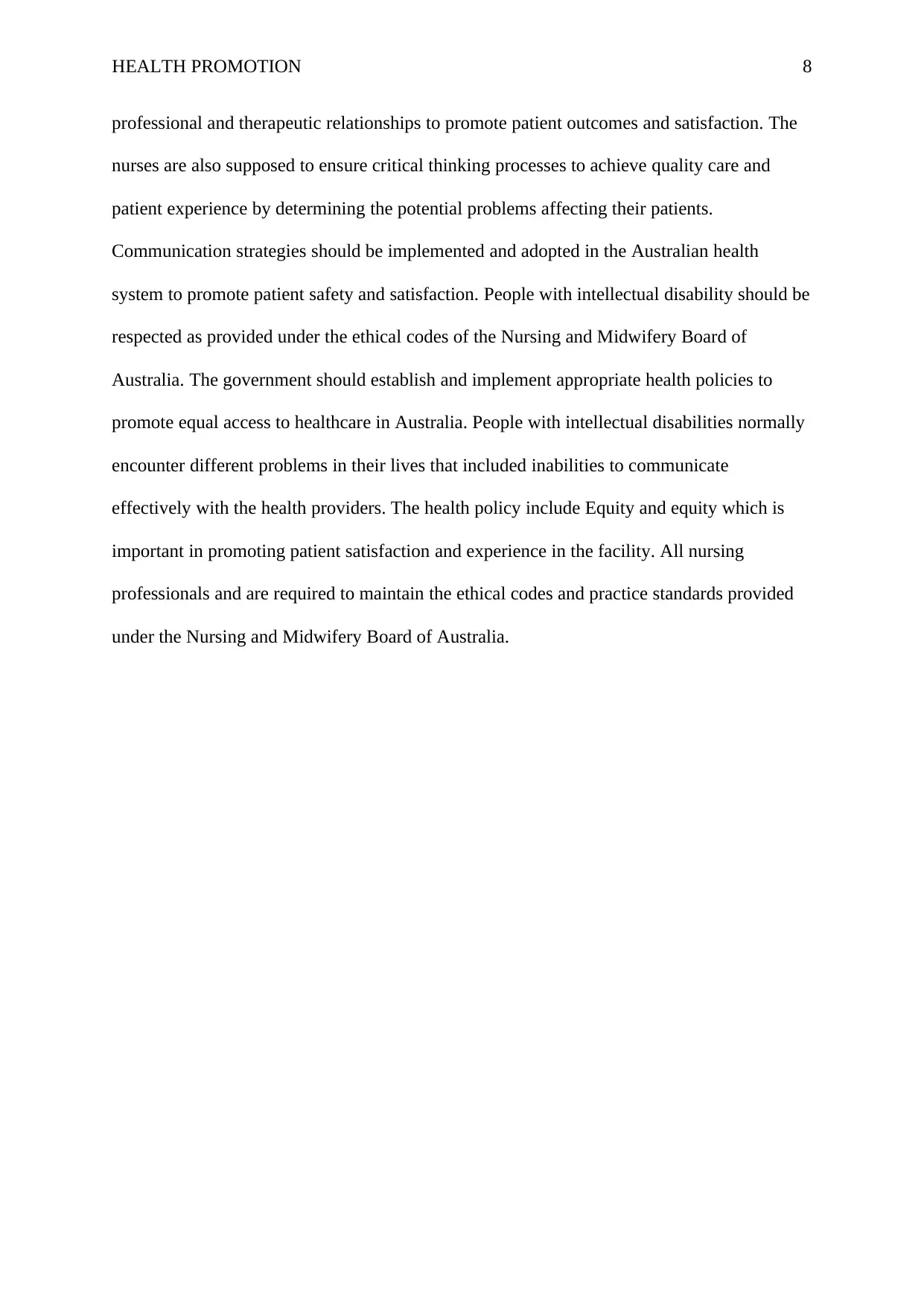
HEALTH PROMOTION 8
professional and therapeutic relationships to promote patient outcomes and satisfaction. The
nurses are also supposed to ensure critical thinking processes to achieve quality care and
patient experience by determining the potential problems affecting their patients.
Communication strategies should be implemented and adopted in the Australian health
system to promote patient safety and satisfaction. People with intellectual disability should be
respected as provided under the ethical codes of the Nursing and Midwifery Board of
Australia. The government should establish and implement appropriate health policies to
promote equal access to healthcare in Australia. People with intellectual disabilities normally
encounter different problems in their lives that included inabilities to communicate
effectively with the health providers. The health policy include Equity and equity which is
important in promoting patient satisfaction and experience in the facility. All nursing
professionals and are required to maintain the ethical codes and practice standards provided
under the Nursing and Midwifery Board of Australia.
professional and therapeutic relationships to promote patient outcomes and satisfaction. The
nurses are also supposed to ensure critical thinking processes to achieve quality care and
patient experience by determining the potential problems affecting their patients.
Communication strategies should be implemented and adopted in the Australian health
system to promote patient safety and satisfaction. People with intellectual disability should be
respected as provided under the ethical codes of the Nursing and Midwifery Board of
Australia. The government should establish and implement appropriate health policies to
promote equal access to healthcare in Australia. People with intellectual disabilities normally
encounter different problems in their lives that included inabilities to communicate
effectively with the health providers. The health policy include Equity and equity which is
important in promoting patient satisfaction and experience in the facility. All nursing
professionals and are required to maintain the ethical codes and practice standards provided
under the Nursing and Midwifery Board of Australia.
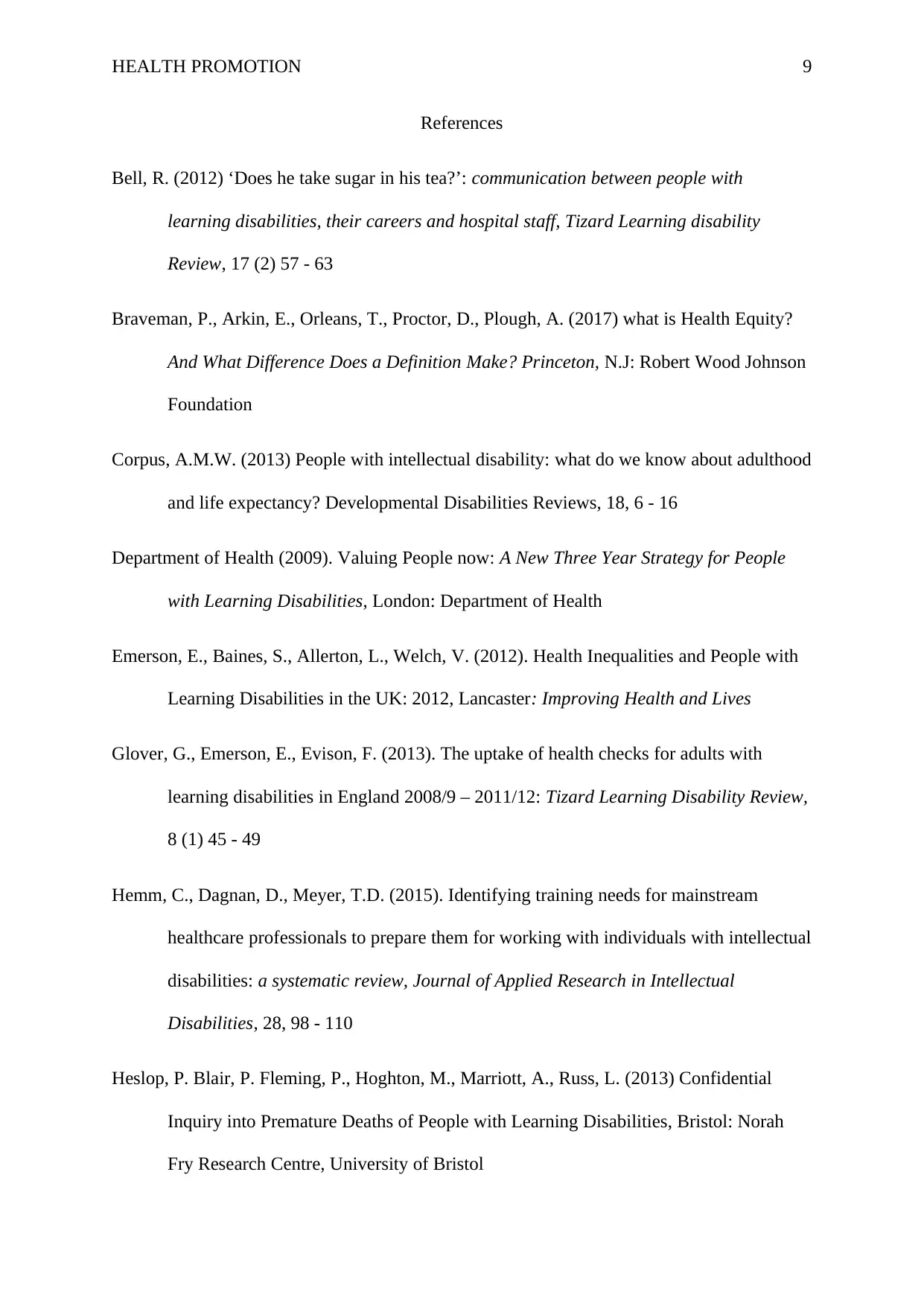
HEALTH PROMOTION 9
References
Bell, R. (2012) ‘Does he take sugar in his tea?’: communication between people with
learning disabilities, their careers and hospital staff, Tizard Learning disability
Review, 17 (2) 57 - 63
Braveman, P., Arkin, E., Orleans, T., Proctor, D., Plough, A. (2017) what is Health Equity?
And What Difference Does a Definition Make? Princeton, N.J: Robert Wood Johnson
Foundation
Corpus, A.M.W. (2013) People with intellectual disability: what do we know about adulthood
and life expectancy? Developmental Disabilities Reviews, 18, 6 - 16
Department of Health (2009). Valuing People now: A New Three Year Strategy for People
with Learning Disabilities, London: Department of Health
Emerson, E., Baines, S., Allerton, L., Welch, V. (2012). Health Inequalities and People with
Learning Disabilities in the UK: 2012, Lancaster: Improving Health and Lives
Glover, G., Emerson, E., Evison, F. (2013). The uptake of health checks for adults with
learning disabilities in England 2008/9 – 2011/12: Tizard Learning Disability Review,
8 (1) 45 - 49
Hemm, C., Dagnan, D., Meyer, T.D. (2015). Identifying training needs for mainstream
healthcare professionals to prepare them for working with individuals with intellectual
disabilities: a systematic review, Journal of Applied Research in Intellectual
Disabilities, 28, 98 - 110
Heslop, P. Blair, P. Fleming, P., Hoghton, M., Marriott, A., Russ, L. (2013) Confidential
Inquiry into Premature Deaths of People with Learning Disabilities, Bristol: Norah
Fry Research Centre, University of Bristol
References
Bell, R. (2012) ‘Does he take sugar in his tea?’: communication between people with
learning disabilities, their careers and hospital staff, Tizard Learning disability
Review, 17 (2) 57 - 63
Braveman, P., Arkin, E., Orleans, T., Proctor, D., Plough, A. (2017) what is Health Equity?
And What Difference Does a Definition Make? Princeton, N.J: Robert Wood Johnson
Foundation
Corpus, A.M.W. (2013) People with intellectual disability: what do we know about adulthood
and life expectancy? Developmental Disabilities Reviews, 18, 6 - 16
Department of Health (2009). Valuing People now: A New Three Year Strategy for People
with Learning Disabilities, London: Department of Health
Emerson, E., Baines, S., Allerton, L., Welch, V. (2012). Health Inequalities and People with
Learning Disabilities in the UK: 2012, Lancaster: Improving Health and Lives
Glover, G., Emerson, E., Evison, F. (2013). The uptake of health checks for adults with
learning disabilities in England 2008/9 – 2011/12: Tizard Learning Disability Review,
8 (1) 45 - 49
Hemm, C., Dagnan, D., Meyer, T.D. (2015). Identifying training needs for mainstream
healthcare professionals to prepare them for working with individuals with intellectual
disabilities: a systematic review, Journal of Applied Research in Intellectual
Disabilities, 28, 98 - 110
Heslop, P. Blair, P. Fleming, P., Hoghton, M., Marriott, A., Russ, L. (2013) Confidential
Inquiry into Premature Deaths of People with Learning Disabilities, Bristol: Norah
Fry Research Centre, University of Bristol
⊘ This is a preview!⊘
Do you want full access?
Subscribe today to unlock all pages.

Trusted by 1+ million students worldwide
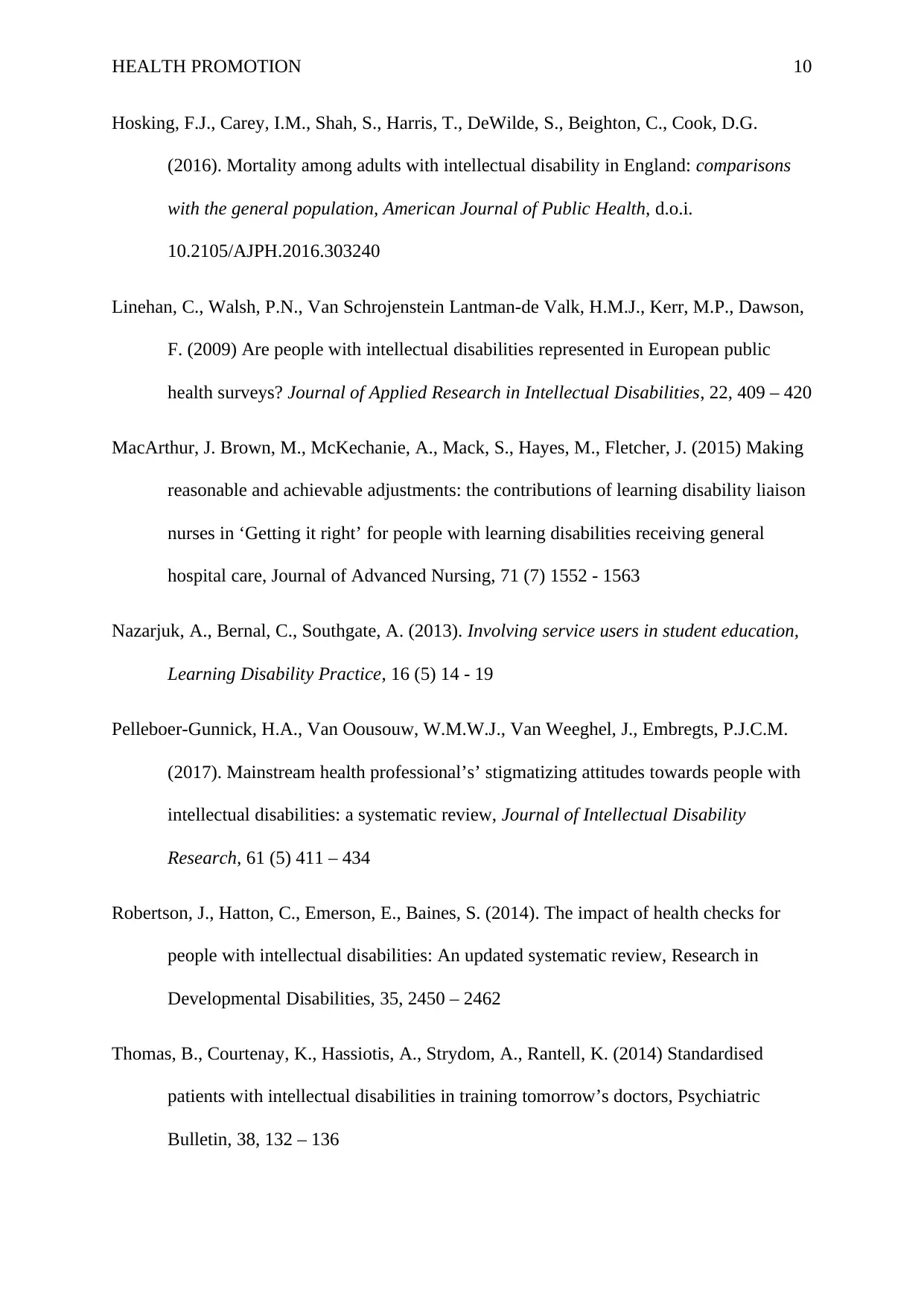
HEALTH PROMOTION 10
Hosking, F.J., Carey, I.M., Shah, S., Harris, T., DeWilde, S., Beighton, C., Cook, D.G.
(2016). Mortality among adults with intellectual disability in England: comparisons
with the general population, American Journal of Public Health, d.o.i.
10.2105/AJPH.2016.303240
Linehan, C., Walsh, P.N., Van Schrojenstein Lantman-de Valk, H.M.J., Kerr, M.P., Dawson,
F. (2009) Are people with intellectual disabilities represented in European public
health surveys? Journal of Applied Research in Intellectual Disabilities, 22, 409 – 420
MacArthur, J. Brown, M., McKechanie, A., Mack, S., Hayes, M., Fletcher, J. (2015) Making
reasonable and achievable adjustments: the contributions of learning disability liaison
nurses in ‘Getting it right’ for people with learning disabilities receiving general
hospital care, Journal of Advanced Nursing, 71 (7) 1552 - 1563
Nazarjuk, A., Bernal, C., Southgate, A. (2013). Involving service users in student education,
Learning Disability Practice, 16 (5) 14 - 19
Pelleboer-Gunnick, H.A., Van Oousouw, W.M.W.J., Van Weeghel, J., Embregts, P.J.C.M.
(2017). Mainstream health professional’s’ stigmatizing attitudes towards people with
intellectual disabilities: a systematic review, Journal of Intellectual Disability
Research, 61 (5) 411 – 434
Robertson, J., Hatton, C., Emerson, E., Baines, S. (2014). The impact of health checks for
people with intellectual disabilities: An updated systematic review, Research in
Developmental Disabilities, 35, 2450 – 2462
Thomas, B., Courtenay, K., Hassiotis, A., Strydom, A., Rantell, K. (2014) Standardised
patients with intellectual disabilities in training tomorrow’s doctors, Psychiatric
Bulletin, 38, 132 – 136
Hosking, F.J., Carey, I.M., Shah, S., Harris, T., DeWilde, S., Beighton, C., Cook, D.G.
(2016). Mortality among adults with intellectual disability in England: comparisons
with the general population, American Journal of Public Health, d.o.i.
10.2105/AJPH.2016.303240
Linehan, C., Walsh, P.N., Van Schrojenstein Lantman-de Valk, H.M.J., Kerr, M.P., Dawson,
F. (2009) Are people with intellectual disabilities represented in European public
health surveys? Journal of Applied Research in Intellectual Disabilities, 22, 409 – 420
MacArthur, J. Brown, M., McKechanie, A., Mack, S., Hayes, M., Fletcher, J. (2015) Making
reasonable and achievable adjustments: the contributions of learning disability liaison
nurses in ‘Getting it right’ for people with learning disabilities receiving general
hospital care, Journal of Advanced Nursing, 71 (7) 1552 - 1563
Nazarjuk, A., Bernal, C., Southgate, A. (2013). Involving service users in student education,
Learning Disability Practice, 16 (5) 14 - 19
Pelleboer-Gunnick, H.A., Van Oousouw, W.M.W.J., Van Weeghel, J., Embregts, P.J.C.M.
(2017). Mainstream health professional’s’ stigmatizing attitudes towards people with
intellectual disabilities: a systematic review, Journal of Intellectual Disability
Research, 61 (5) 411 – 434
Robertson, J., Hatton, C., Emerson, E., Baines, S. (2014). The impact of health checks for
people with intellectual disabilities: An updated systematic review, Research in
Developmental Disabilities, 35, 2450 – 2462
Thomas, B., Courtenay, K., Hassiotis, A., Strydom, A., Rantell, K. (2014) Standardised
patients with intellectual disabilities in training tomorrow’s doctors, Psychiatric
Bulletin, 38, 132 – 136
Paraphrase This Document
Need a fresh take? Get an instant paraphrase of this document with our AI Paraphraser
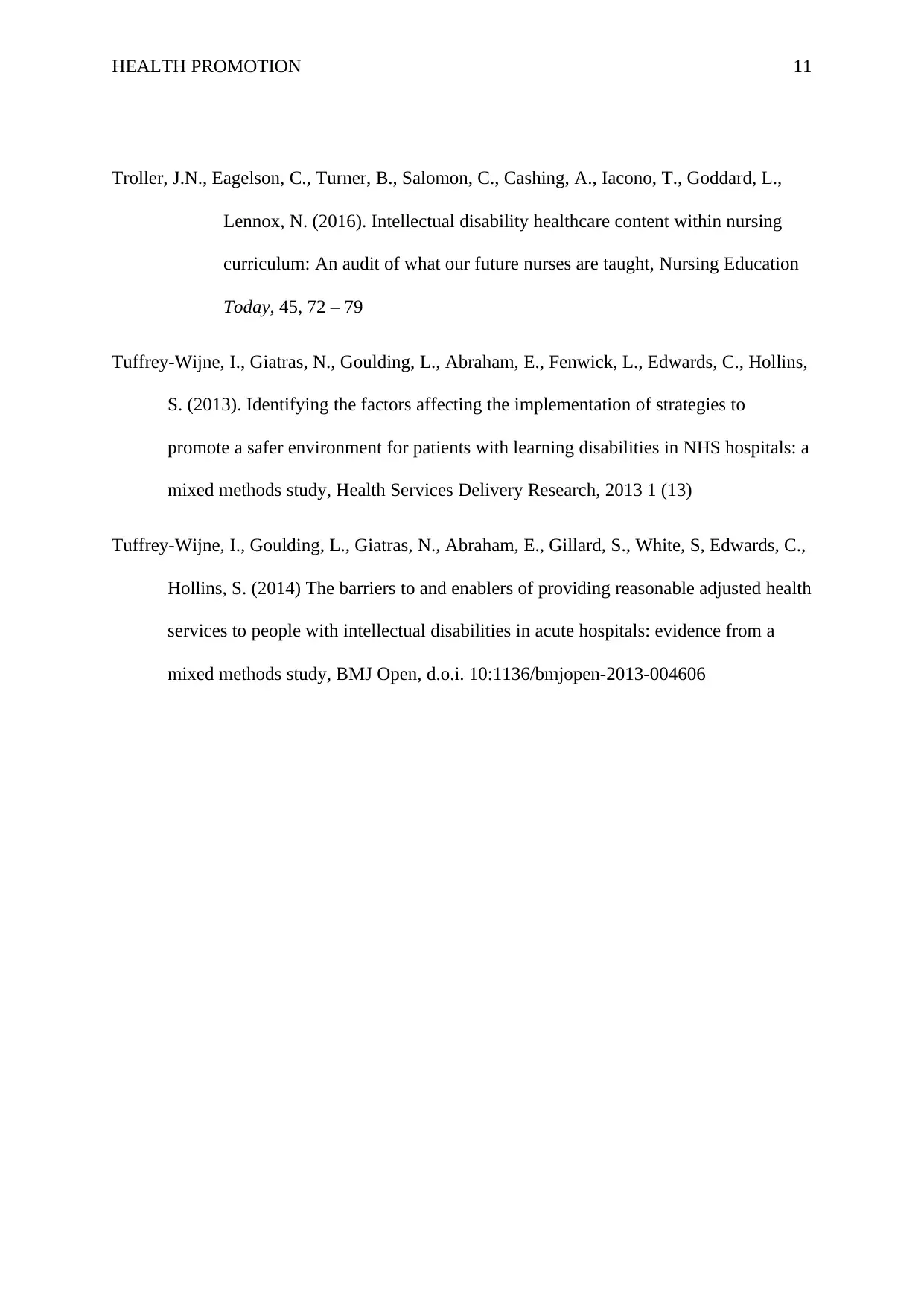
HEALTH PROMOTION 11
Troller, J.N., Eagelson, C., Turner, B., Salomon, C., Cashing, A., Iacono, T., Goddard, L.,
Lennox, N. (2016). Intellectual disability healthcare content within nursing
curriculum: An audit of what our future nurses are taught, Nursing Education
Today, 45, 72 – 79
Tuffrey-Wijne, I., Giatras, N., Goulding, L., Abraham, E., Fenwick, L., Edwards, C., Hollins,
S. (2013). Identifying the factors affecting the implementation of strategies to
promote a safer environment for patients with learning disabilities in NHS hospitals: a
mixed methods study, Health Services Delivery Research, 2013 1 (13)
Tuffrey-Wijne, I., Goulding, L., Giatras, N., Abraham, E., Gillard, S., White, S, Edwards, C.,
Hollins, S. (2014) The barriers to and enablers of providing reasonable adjusted health
services to people with intellectual disabilities in acute hospitals: evidence from a
mixed methods study, BMJ Open, d.o.i. 10:1136/bmjopen-2013-004606
Troller, J.N., Eagelson, C., Turner, B., Salomon, C., Cashing, A., Iacono, T., Goddard, L.,
Lennox, N. (2016). Intellectual disability healthcare content within nursing
curriculum: An audit of what our future nurses are taught, Nursing Education
Today, 45, 72 – 79
Tuffrey-Wijne, I., Giatras, N., Goulding, L., Abraham, E., Fenwick, L., Edwards, C., Hollins,
S. (2013). Identifying the factors affecting the implementation of strategies to
promote a safer environment for patients with learning disabilities in NHS hospitals: a
mixed methods study, Health Services Delivery Research, 2013 1 (13)
Tuffrey-Wijne, I., Goulding, L., Giatras, N., Abraham, E., Gillard, S., White, S, Edwards, C.,
Hollins, S. (2014) The barriers to and enablers of providing reasonable adjusted health
services to people with intellectual disabilities in acute hospitals: evidence from a
mixed methods study, BMJ Open, d.o.i. 10:1136/bmjopen-2013-004606
1 out of 11
Related Documents
Your All-in-One AI-Powered Toolkit for Academic Success.
+13062052269
info@desklib.com
Available 24*7 on WhatsApp / Email
![[object Object]](/_next/static/media/star-bottom.7253800d.svg)
Unlock your academic potential
Copyright © 2020–2025 A2Z Services. All Rights Reserved. Developed and managed by ZUCOL.





